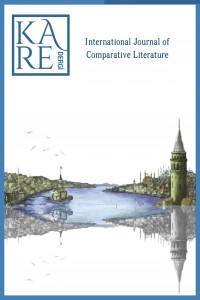Ömer Seyfettin’in “Mehdi” Hikâyesini Kronotop Kavramıyla Okumak
READING OMER SEYFETTIN’S “MAHDI’S STORY” WITH THE CONCEPT OF CHRONOTOPES
Ömer Seyfettin, Mehdi, Bakhtin, chronotope, time, space,
___
- BACHELARD, Gaston. Mekânın Poetikası, Çev., Alp Tümertekin. İstanbul: İthaki Yayınları, 1996.
- BAKHTİN, Mikhail. “Romanda Zaman ve Kronotop Biçimlerine İlişkin Sonuç Niteliğinde Kanılar”, Karnavaldan Romana, Der., Sibel Irzık. İstanbul: Ayrıntı Yayınları, 2020.
- DEMİR, Ayşe. “Ömer Seyfettin’in Hikâyelerinde Millî Kimlik İnşa Unsuru Olarak Mekân”. Uluslararası Asya ve Kuzey Afrika Çalışmaları Kongresi ICANAS Bildirileri, Ankara, 2007, s. 195-207.
- DEMİR, Ayşe. Mekânın Hikâyesi Hikâyenin Mekânı, İstanbul: Kesit Yayınları, 2011.
- HALBWACHS, Maurice. Kolektif Bellek, Çev., Zuhal Karagöz. İstanbul: Pinhan Yayıncılık, 2019.
- KARAARSLAN, Faruk. Toplumsal Hafıza, İstanbul: Ketebe Yayınları, 2019.
- SEYFETTİN, Ömer. Hikâyeler 1, Haz., Hülya Argunşah. İstanbul: Dergâh Yayınları, 2020. s. 357-364.
- YÜCEL, Tahsin. Anlatı Yerlemleri, İstanbul: Yapı Kredi Yayınları, 2019.
- ISSN: 2536-4596
- Yayın Aralığı: Yılda 2 Sayı
- Başlangıç: 2016
- Yayıncı: Hasan BAKTIR
Ömer Seyfettin’in “Başını Vermeyen Şehit” Hikâyesini Yeni Tarihselcilik Bağlamında Okuma Denemesi
Ömer Seyfettin’in “Mehdi” Hikâyesini Kronotop Kavramıyla Okumak
Ömer Seyfettin’in “At” Hikâyesinde Temanın Kurgulanışına Psikomitolojik Bir Yaklaşım
Ömer Seyfettin’in “Ashab-ı Kehfimiz” Hikâyesinde Millî Kimlik ve Öteki
‘Ömer Seyfettin Hikâyelerini Yeniden Okumak’ Odağında Ömer Seyfettin Çalışmaları Üzerine Düşünceler
Halk İnanışlarında Cinsiyet Değiştirme Motifi Bağlamında Ömer Seyfettin’in “Eleğimsağma” Hikâyesi
Ömer Seyfettin Hikâyelerinde Savaşın Kadın Yüzleri: “Nakarat”
Ömer Seyfettin İle İlgili Son Çalışmalar (2019-2020)
Ömer Seyfettin’in Dil Yazılarındaki Düşünceleri ve Yansımaları
Haz. Alev Sınar Uğurlu, Selçuk Kırlı, Vefatının 100. Yılında Ömer Seyfettin’e Armağan.
